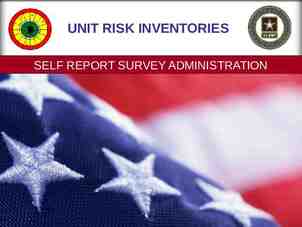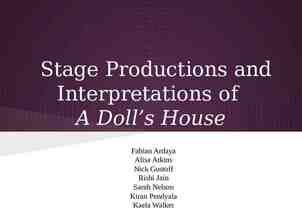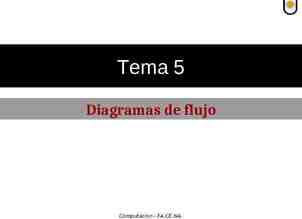Accounting and Financial Reporting Back to Table of Contents
44 Slides3.48 MB
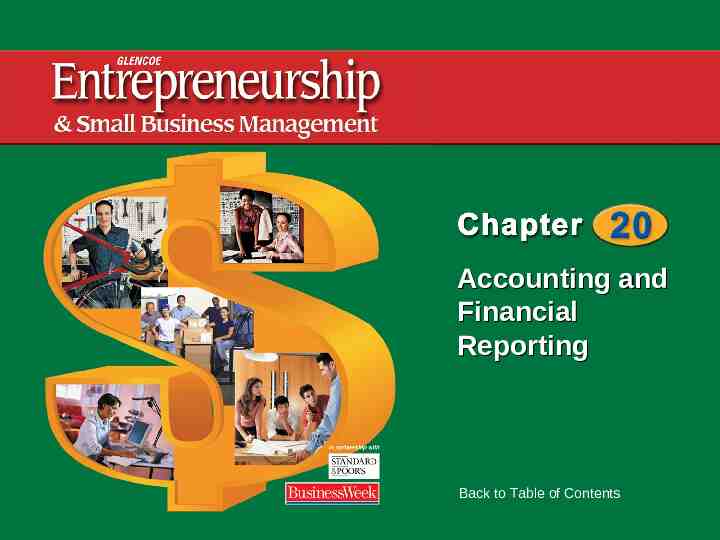
Accounting and Financial Reporting Back to Table of Contents
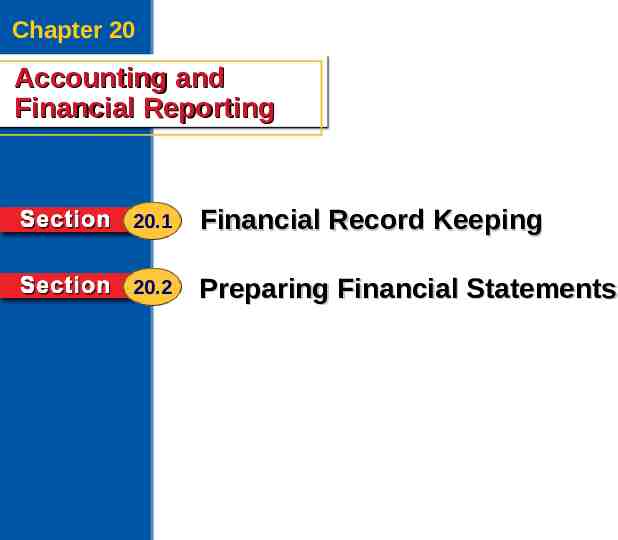
Chapter 20 Accounting and Financial Reporting Accounting and Financial Reporting 20.1 Financial Record Keeping 20.2 Preparing Financial Statements 2
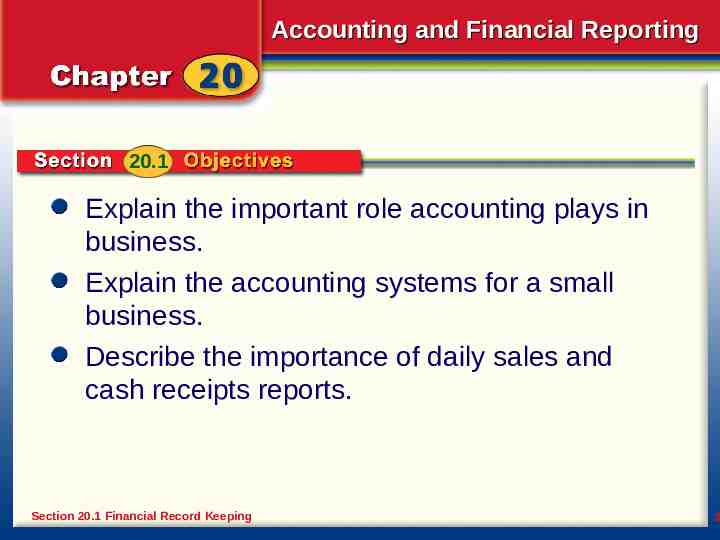
Accounting and Financial Reporting 20.1 Explain the important role accounting plays in business. Explain the accounting systems for a small business. Describe the importance of daily sales and cash receipts reports. Section 20.1 Financial Record Keeping 3
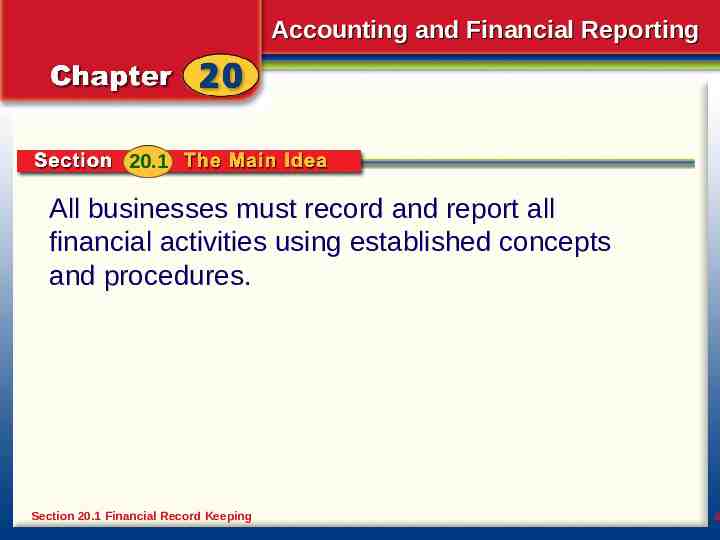
Accounting and Financial Reporting 20.1 All businesses must record and report all financial activities using established concepts and procedures. Section 20.1 Financial Record Keeping 4
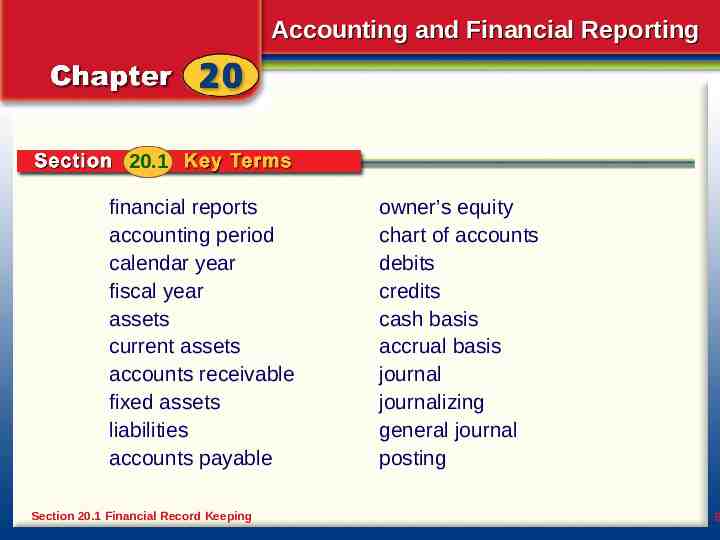
Accounting and Financial Reporting 20.1 financial reports accounting period calendar year fiscal year assets current assets accounts receivable fixed assets liabilities accounts payable Section 20.1 Financial Record Keeping owner’s equity chart of accounts debits credits cash basis accrual basis journal journalizing general journal posting 5
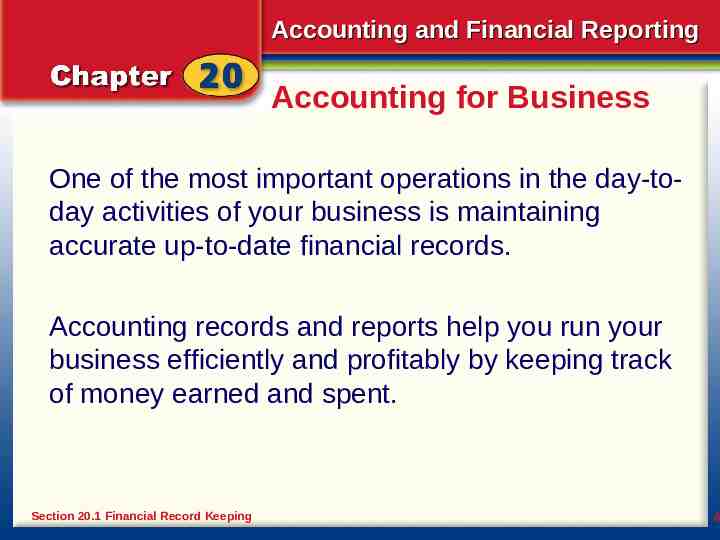
Accounting and Financial Reporting Accounting for Business One of the most important operations in the day-today activities of your business is maintaining accurate up-to-date financial records. Accounting records and reports help you run your business efficiently and profitably by keeping track of money earned and spent. Section 20.1 Financial Record Keeping 6
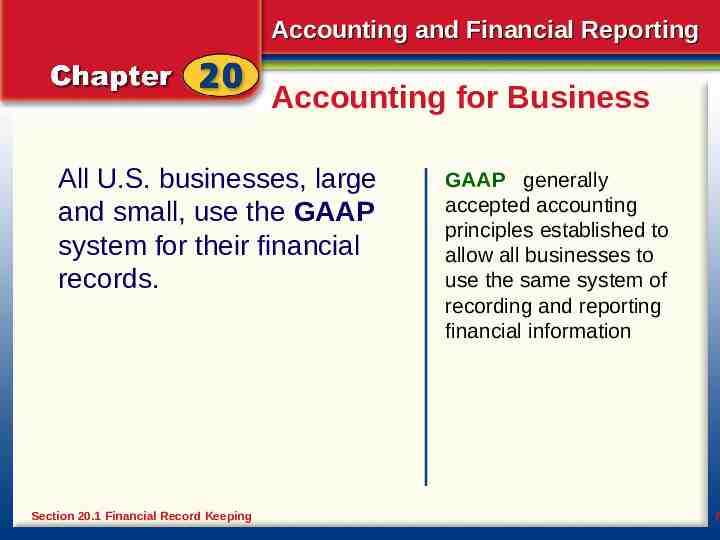
Accounting and Financial Reporting Accounting for Business All U.S. businesses, large and small, use the GAAP system for their financial records. Section 20.1 Financial Record Keeping GAAP generally accepted accounting principles established to allow all businesses to use the same system of recording and reporting financial information 7
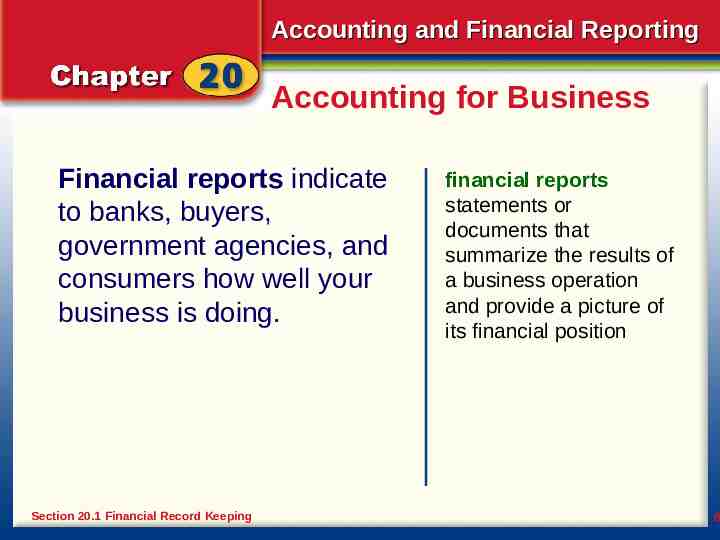
Accounting and Financial Reporting Accounting for Business Financial reports indicate to banks, buyers, government agencies, and consumers how well your business is doing. Section 20.1 Financial Record Keeping financial reports statements or documents that summarize the results of a business operation and provide a picture of its financial position 8
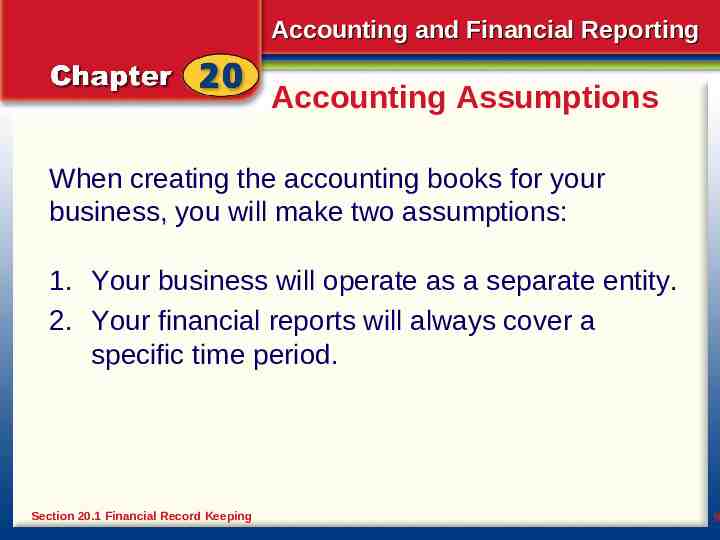
Accounting and Financial Reporting Accounting Assumptions When creating the accounting books for your business, you will make two assumptions: 1. Your business will operate as a separate entity. 2. Your financial reports will always cover a specific time period. Section 20.1 Financial Record Keeping 9
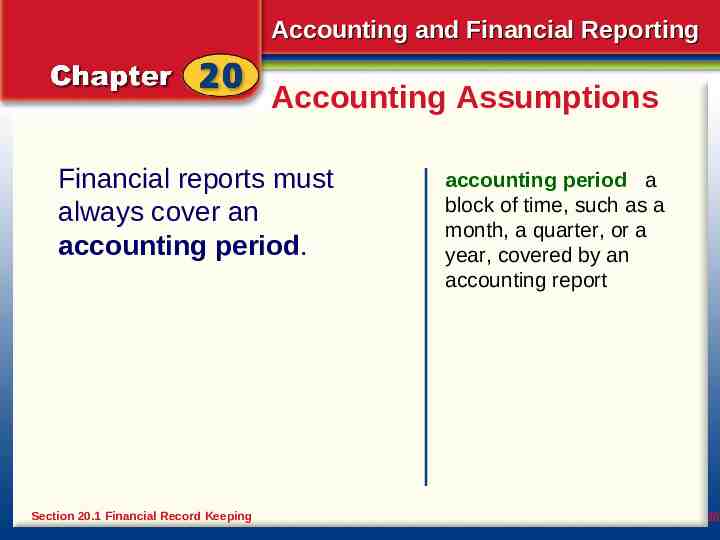
Accounting and Financial Reporting Accounting Assumptions Financial reports must always cover an accounting period. Section 20.1 Financial Record Keeping accounting period a block of time, such as a month, a quarter, or a year, covered by an accounting report 10
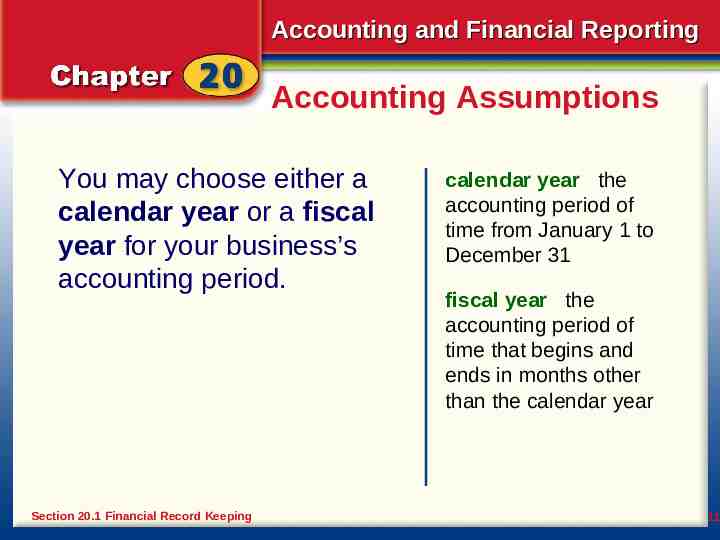
Accounting and Financial Reporting Accounting Assumptions You may choose either a calendar year or a fiscal year for your business’s accounting period. Section 20.1 Financial Record Keeping calendar year the accounting period of time from January 1 to December 31 fiscal year the accounting period of time that begins and ends in months other than the calendar year 11
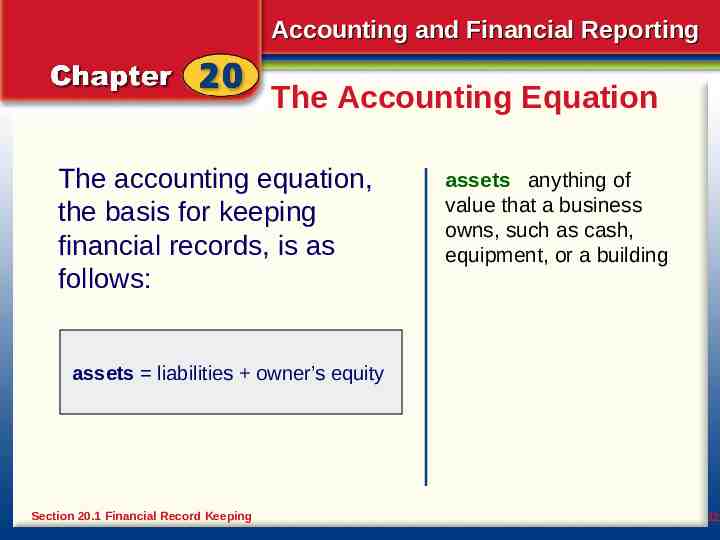
Accounting and Financial Reporting The Accounting Equation The accounting equation, the basis for keeping financial records, is as follows: assets anything of value that a business owns, such as cash, equipment, or a building assets liabilities owner’s equity Section 20.1 Financial Record Keeping 12
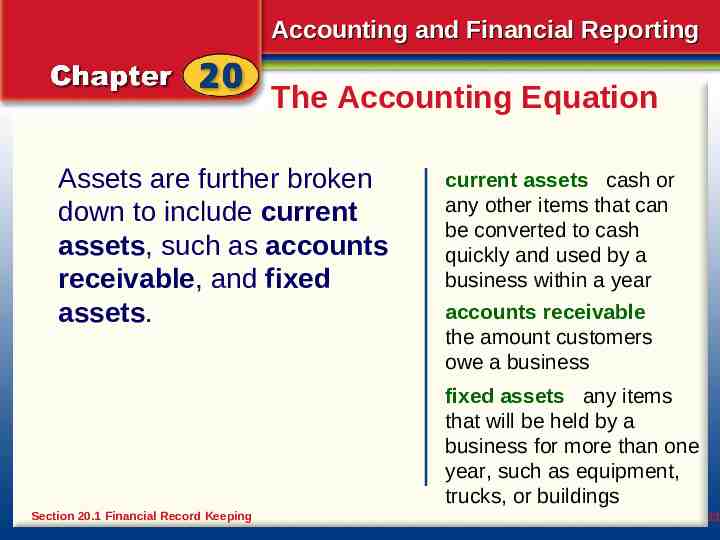
Accounting and Financial Reporting The Accounting Equation Assets are further broken down to include current assets, such as accounts receivable, and fixed assets. current assets cash or any other items that can be converted to cash quickly and used by a business within a year accounts receivable the amount customers owe a business fixed assets any items that will be held by a business for more than one year, such as equipment, trucks, or buildings Section 20.1 Financial Record Keeping 13
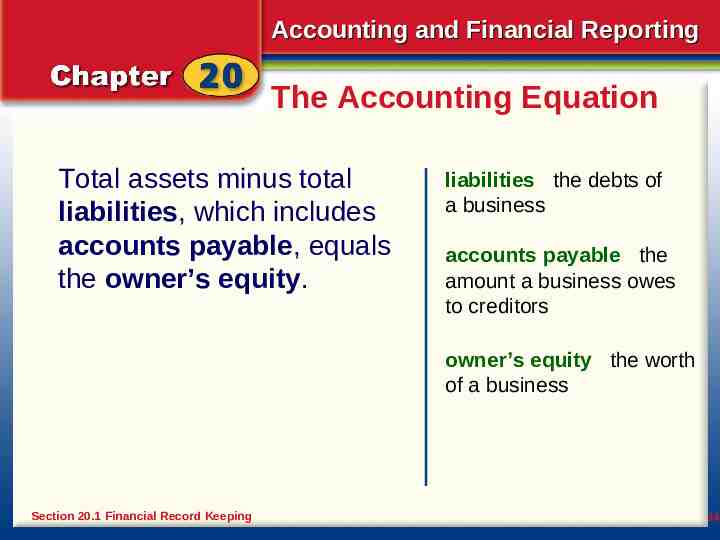
Accounting and Financial Reporting The Accounting Equation Total assets minus total liabilities, which includes accounts payable, equals the owner’s equity. liabilities the debts of a business accounts payable the amount a business owes to creditors owner’s equity the worth of a business Section 20.1 Financial Record Keeping 14
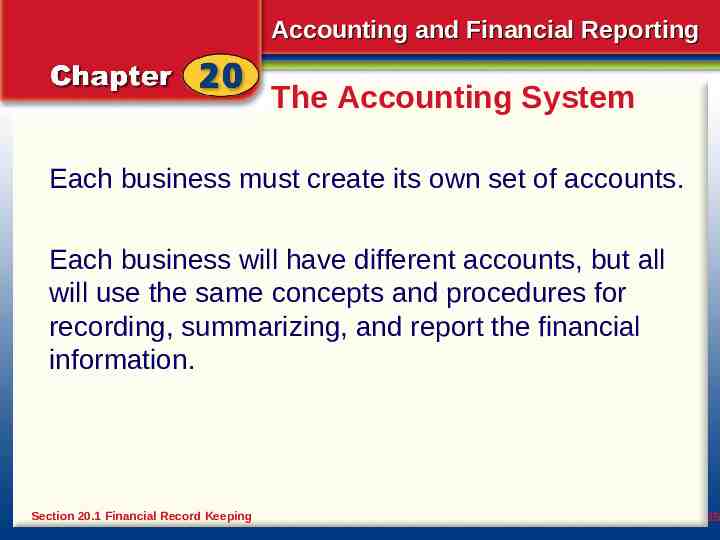
Accounting and Financial Reporting The Accounting System Each business must create its own set of accounts. Each business will have different accounts, but all will use the same concepts and procedures for recording, summarizing, and report the financial information. Section 20.1 Financial Record Keeping 15
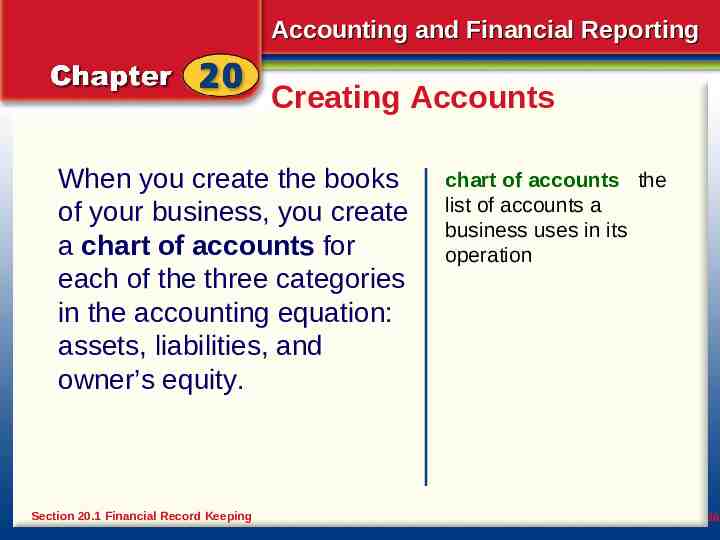
Accounting and Financial Reporting Creating Accounts When you create the books of your business, you create a chart of accounts for each of the three categories in the accounting equation: assets, liabilities, and owner’s equity. Section 20.1 Financial Record Keeping chart of accounts the list of accounts a business uses in its operation 16
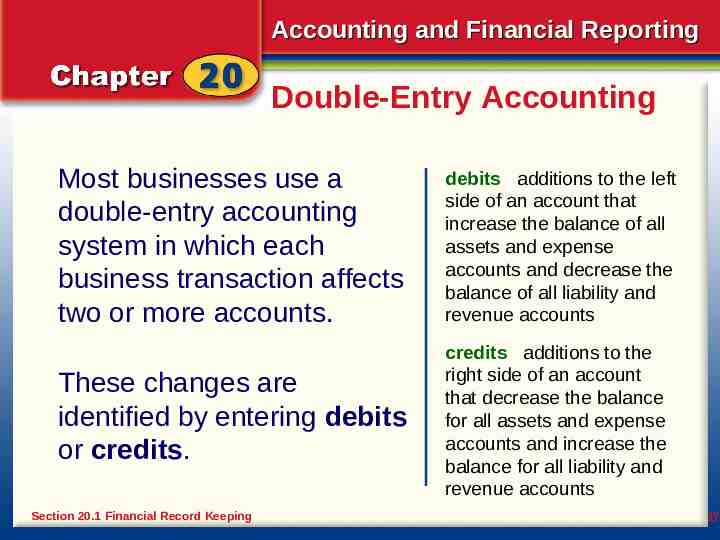
Accounting and Financial Reporting Double-Entry Accounting Most businesses use a double-entry accounting system in which each business transaction affects two or more accounts. debits additions to the left side of an account that increase the balance of all assets and expense accounts and decrease the balance of all liability and revenue accounts These changes are identified by entering debits or credits. credits additions to the right side of an account that decrease the balance for all assets and expense accounts and increase the balance for all liability and revenue accounts Section 20.1 Financial Record Keeping 17
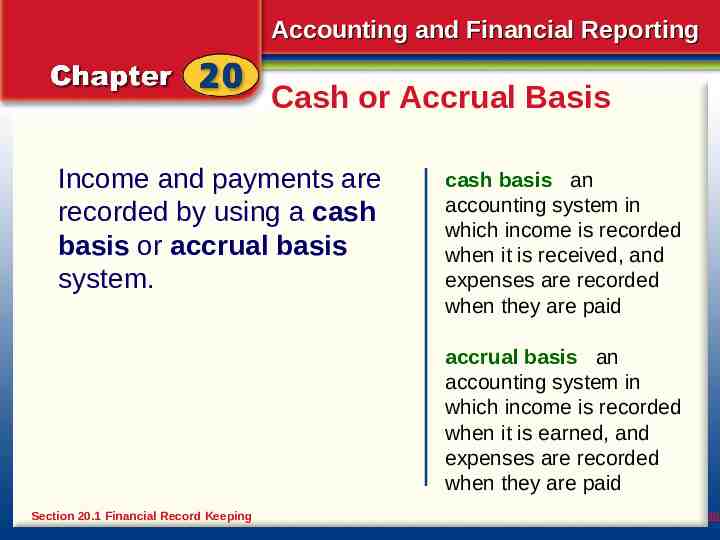
Accounting and Financial Reporting Cash or Accrual Basis Income and payments are recorded by using a cash basis or accrual basis system. cash basis an accounting system in which income is recorded when it is received, and expenses are recorded when they are paid accrual basis an accounting system in which income is recorded when it is earned, and expenses are recorded when they are paid Section 20.1 Financial Record Keeping 18
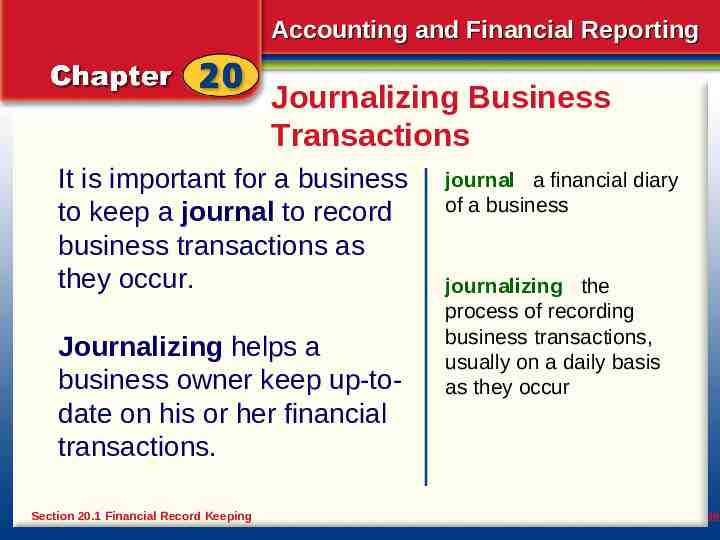
Accounting and Financial Reporting Journalizing Business Transactions It is important for a business to keep a journal to record business transactions as they occur. Journalizing helps a business owner keep up-todate on his or her financial transactions. Section 20.1 Financial Record Keeping journal a financial diary of a business journalizing the process of recording business transactions, usually on a daily basis as they occur 19
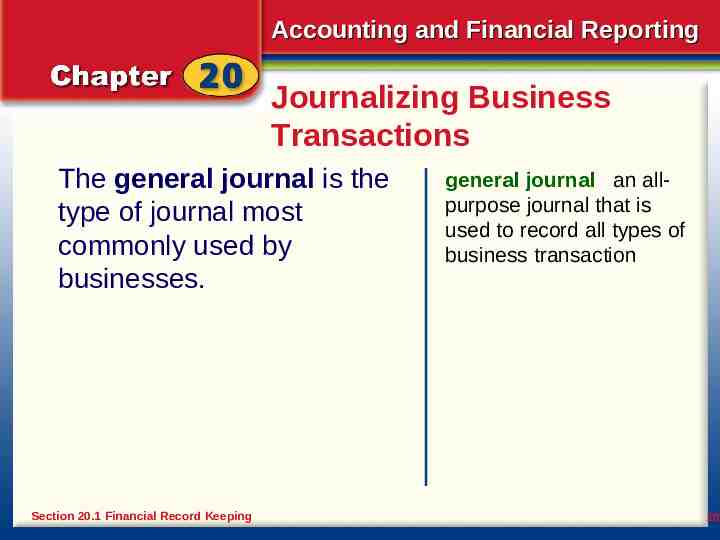
Accounting and Financial Reporting Journalizing Business Transactions The general journal is the type of journal most commonly used by businesses. Section 20.1 Financial Record Keeping general journal an allpurpose journal that is used to record all types of business transaction 20
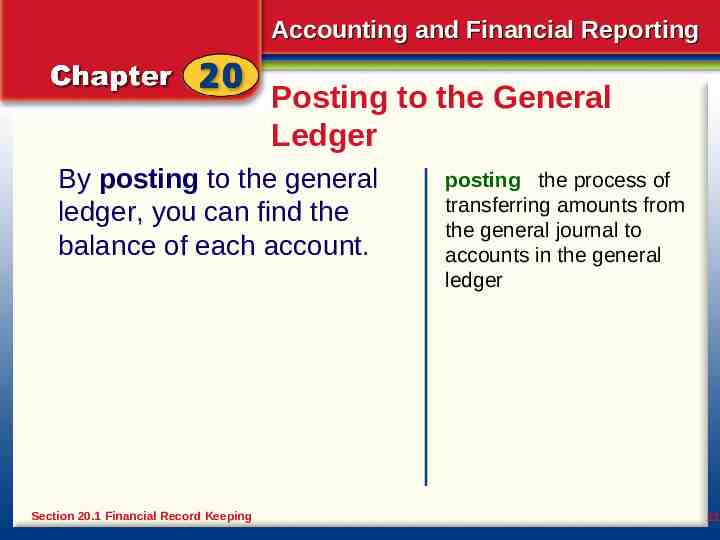
Accounting and Financial Reporting Posting to the General Ledger By posting to the general ledger, you can find the balance of each account. Section 20.1 Financial Record Keeping posting the process of transferring amounts from the general journal to accounts in the general ledger 21
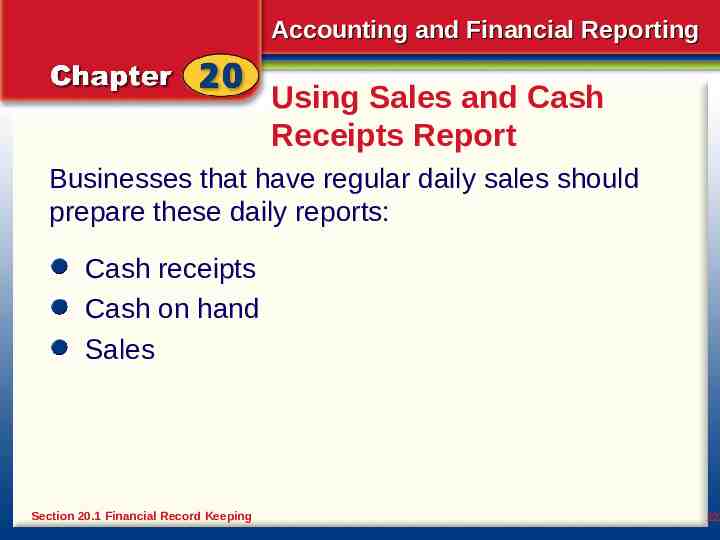
Accounting and Financial Reporting Using Sales and Cash Receipts Report Businesses that have regular daily sales should prepare these daily reports: Cash receipts Cash on hand Sales Section 20.1 Financial Record Keeping 22
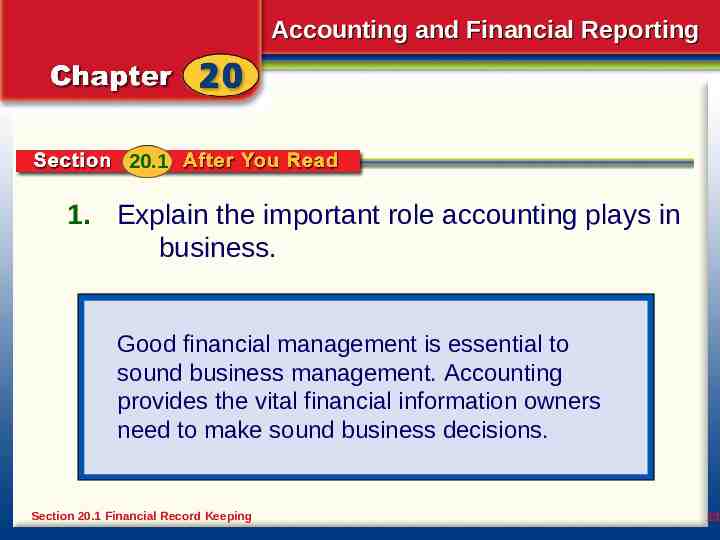
Accounting and Financial Reporting 20.1 1. Explain the important role accounting plays in business. Good financial management is essential to sound business management. Accounting provides the vital financial information owners need to make sound business decisions. Section 20.1 Financial Record Keeping 23
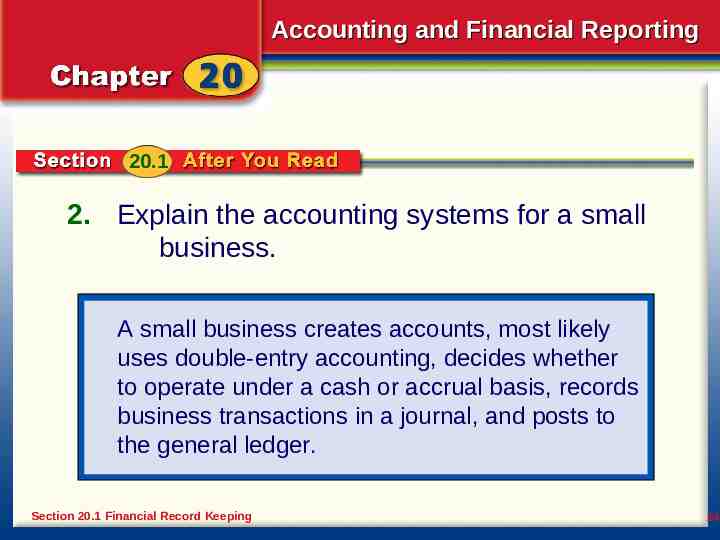
Accounting and Financial Reporting 20.1 2. Explain the accounting systems for a small business. A small business creates accounts, most likely uses double-entry accounting, decides whether to operate under a cash or accrual basis, records business transactions in a journal, and posts to the general ledger. Section 20.1 Financial Record Keeping 24
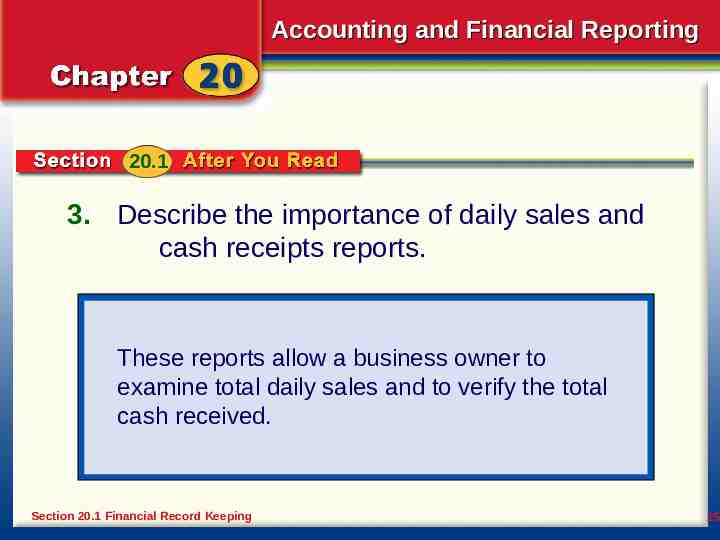
Accounting and Financial Reporting 20.1 3. Describe the importance of daily sales and cash receipts reports. These reports allow a business owner to examine total daily sales and to verify the total cash received. Section 20.1 Financial Record Keeping 25
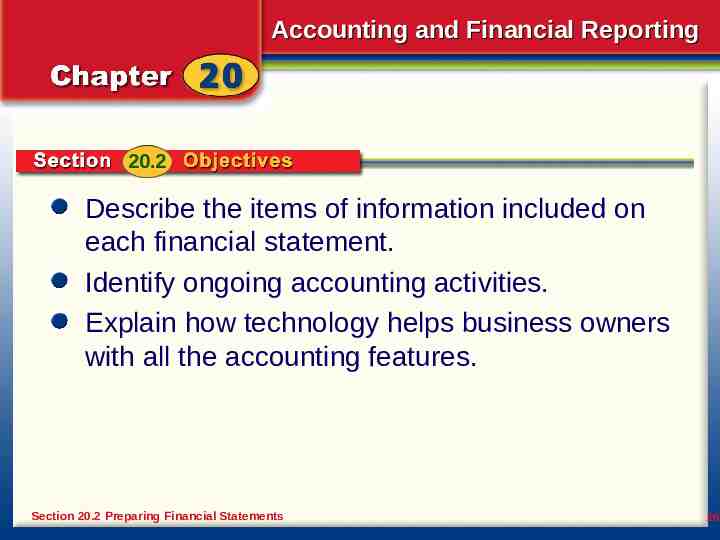
Accounting and Financial Reporting 20.2 Describe the items of information included on each financial statement. Identify ongoing accounting activities. Explain how technology helps business owners with all the accounting features. Section 20.2 Preparing Financial Statements 26
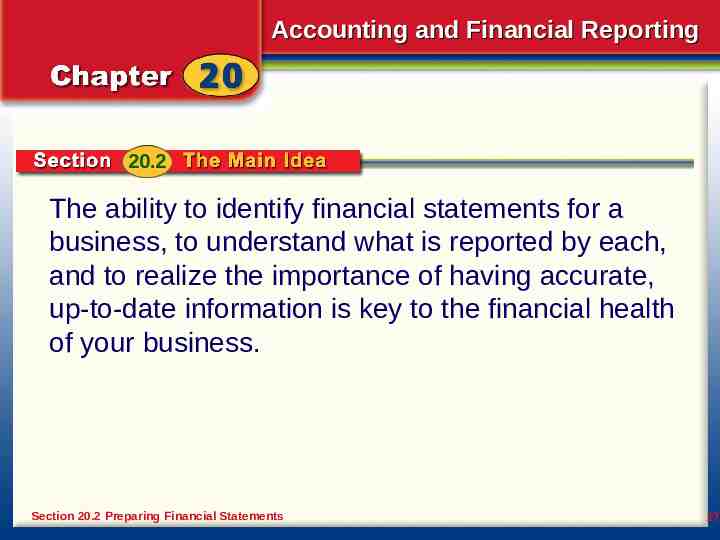
Accounting and Financial Reporting 20.2 The ability to identify financial statements for a business, to understand what is reported by each, and to realize the importance of having accurate, up-to-date information is key to the financial health of your business. Section 20.2 Preparing Financial Statements 27
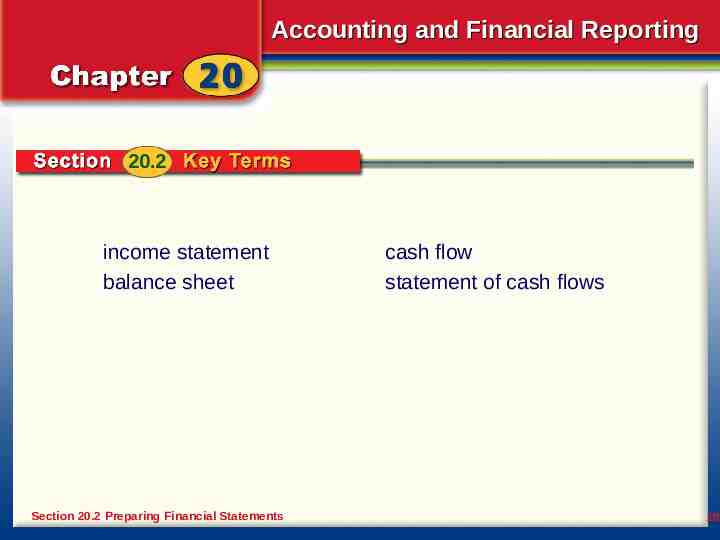
Accounting and Financial Reporting 20.2 income statement balance sheet Section 20.2 Preparing Financial Statements cash flow statement of cash flows 28
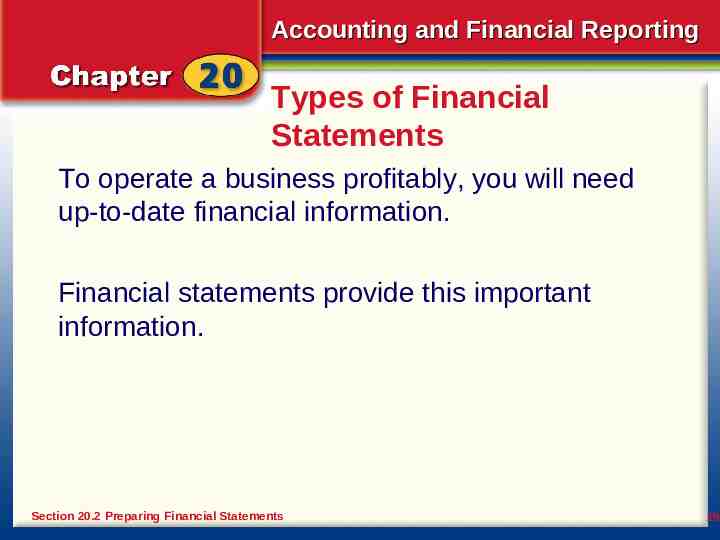
Accounting and Financial Reporting Types of Financial Statements To operate a business profitably, you will need up-to-date financial information. Financial statements provide this important information. Section 20.2 Preparing Financial Statements 29
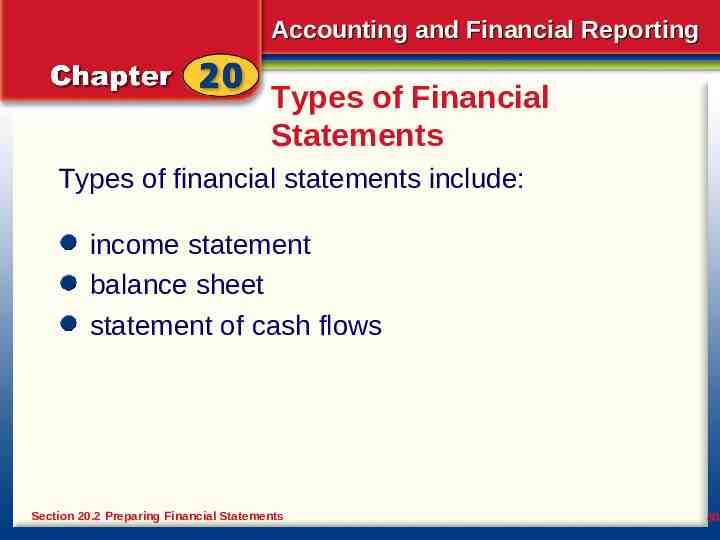
Accounting and Financial Reporting Types of Financial Statements Types of financial statements include: income statement balance sheet statement of cash flows Section 20.2 Preparing Financial Statements 30
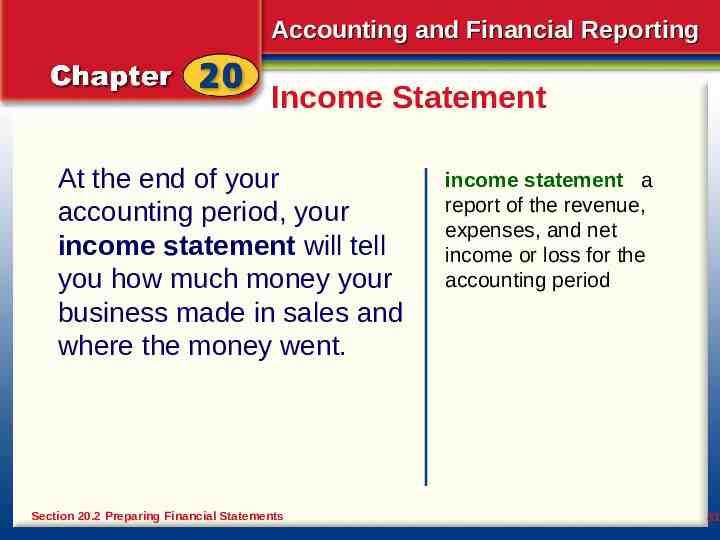
Accounting and Financial Reporting Income Statement At the end of your accounting period, your income statement will tell you how much money your business made in sales and where the money went. Section 20.2 Preparing Financial Statements income statement a report of the revenue, expenses, and net income or loss for the accounting period 31
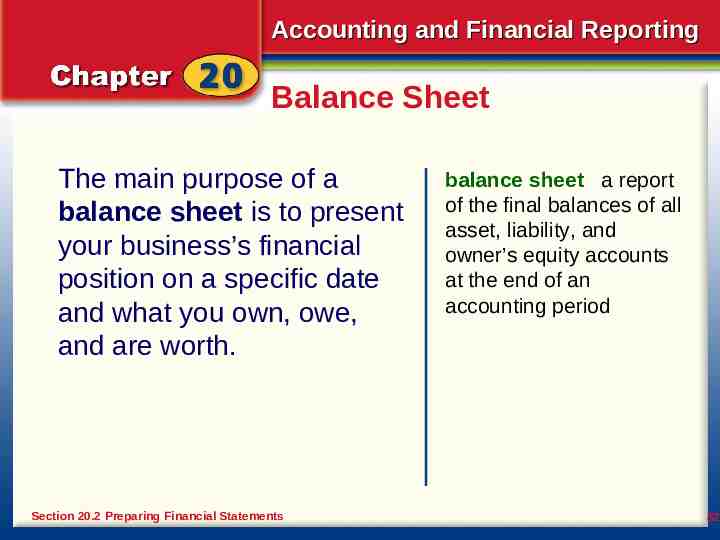
Accounting and Financial Reporting Balance Sheet The main purpose of a balance sheet is to present your business’s financial position on a specific date and what you own, owe, and are worth. Section 20.2 Preparing Financial Statements balance sheet a report of the final balances of all asset, liability, and owner’s equity accounts at the end of an accounting period 32
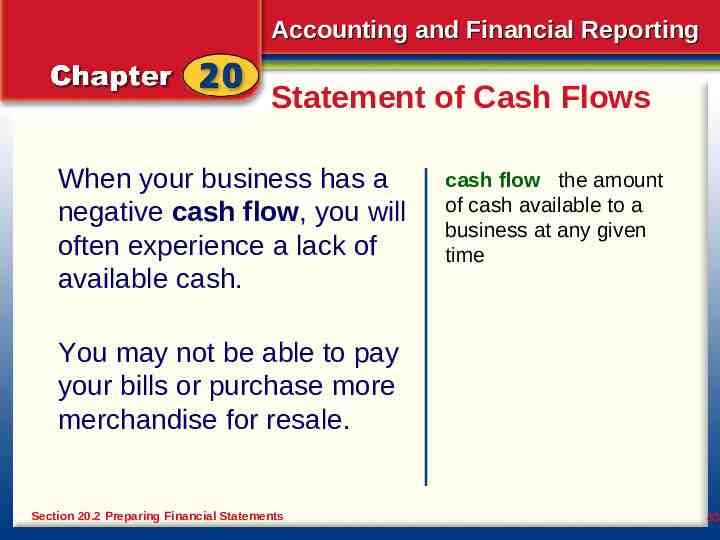
Accounting and Financial Reporting Statement of Cash Flows When your business has a negative cash flow, you will often experience a lack of available cash. cash flow the amount of cash available to a business at any given time You may not be able to pay your bills or purchase more merchandise for resale. Section 20.2 Preparing Financial Statements 33
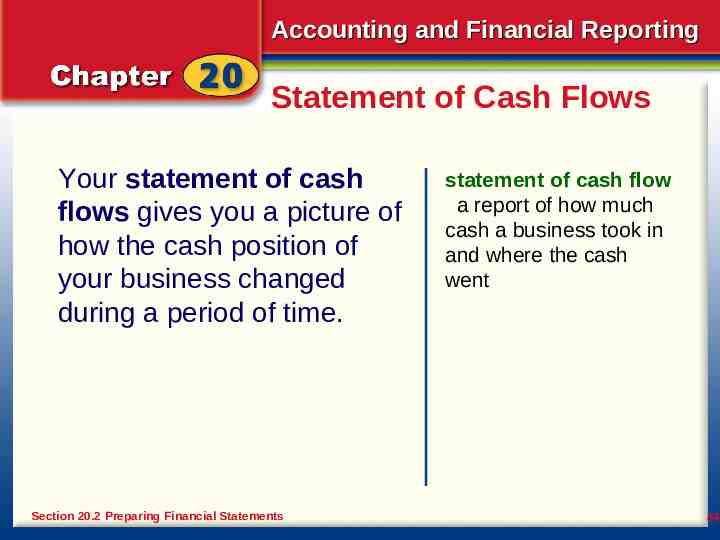
Accounting and Financial Reporting Statement of Cash Flows Your statement of cash flows gives you a picture of how the cash position of your business changed during a period of time. Section 20.2 Preparing Financial Statements statement of cash flow a report of how much cash a business took in and where the cash went 34
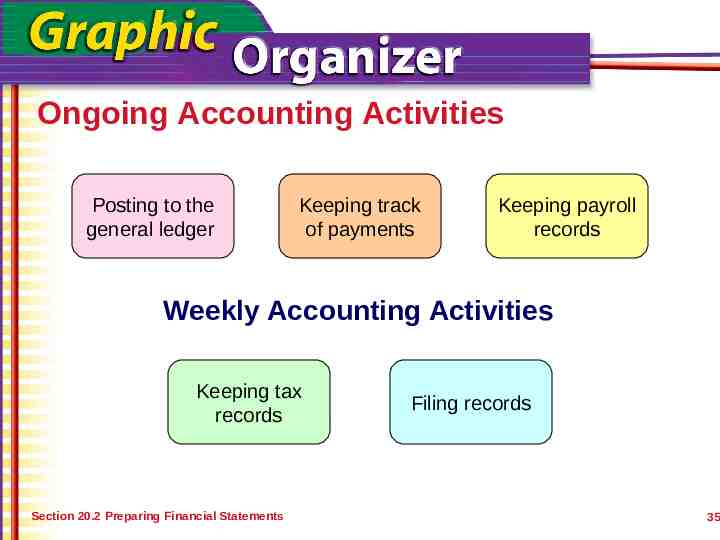
Ongoing Accounting Activities Posting to the general ledger Keeping track of payments Keeping payroll records Weekly Accounting Activities Keeping tax records Section 20.2 Preparing Financial Statements Filing records 35
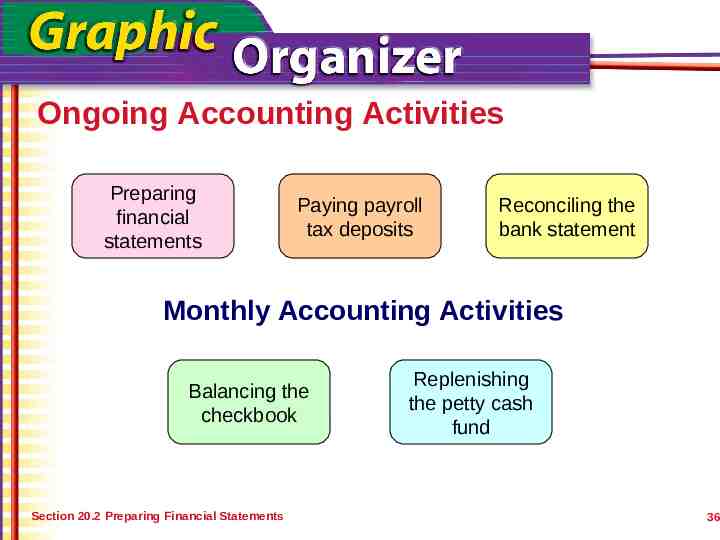
Ongoing Accounting Activities Preparing financial statements Paying payroll tax deposits Reconciling the bank statement Monthly Accounting Activities Balancing the checkbook Section 20.2 Preparing Financial Statements Replenishing the petty cash fund 36
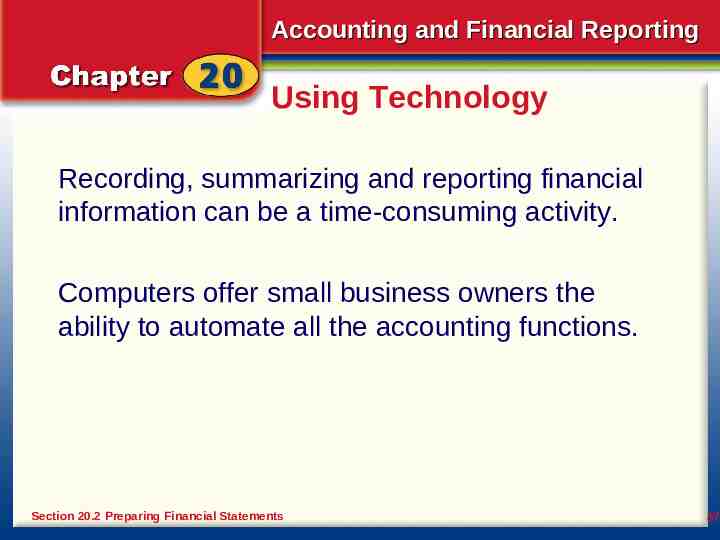
Accounting and Financial Reporting Using Technology Recording, summarizing and reporting financial information can be a time-consuming activity. Computers offer small business owners the ability to automate all the accounting functions. Section 20.2 Preparing Financial Statements 37
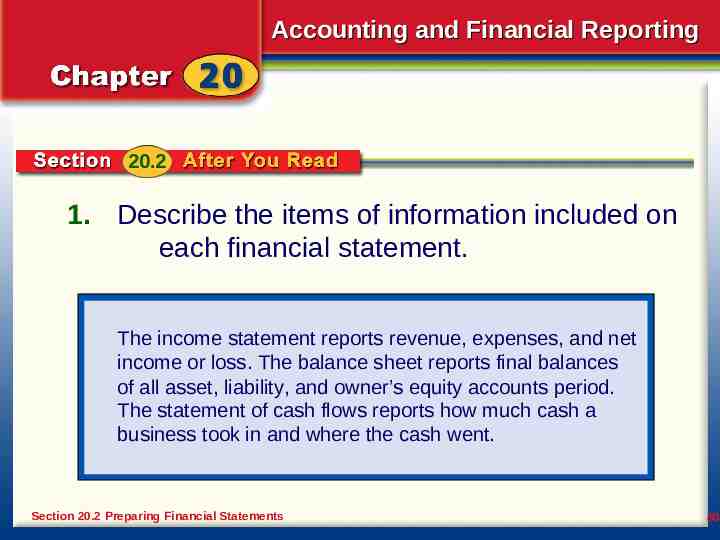
Accounting and Financial Reporting 20.2 1. Describe the items of information included on each financial statement. The income statement reports revenue, expenses, and net income or loss. The balance sheet reports final balances of all asset, liability, and owner’s equity accounts period. The statement of cash flows reports how much cash a business took in and where the cash went. Section 20.2 Preparing Financial Statements 38
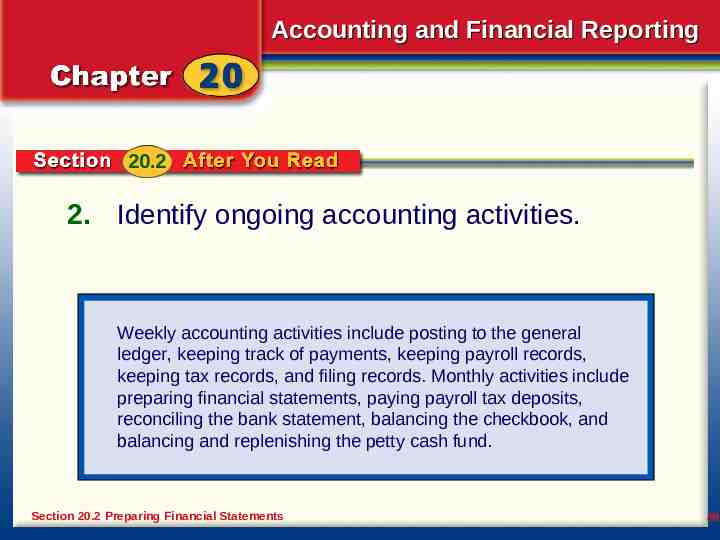
Accounting and Financial Reporting 20.2 2. Identify ongoing accounting activities. Weekly accounting activities include posting to the general ledger, keeping track of payments, keeping payroll records, keeping tax records, and filing records. Monthly activities include preparing financial statements, paying payroll tax deposits, reconciling the bank statement, balancing the checkbook, and balancing and replenishing the petty cash fund. Section 20.2 Preparing Financial Statements 39
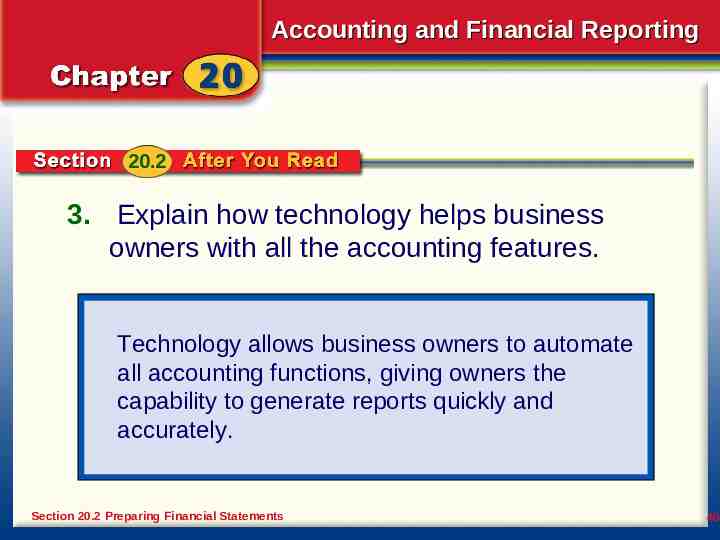
Accounting and Financial Reporting 20.2 3. Explain how technology helps business owners with all the accounting features. Technology allows business owners to automate all accounting functions, giving owners the capability to generate reports quickly and accurately. Section 20.2 Preparing Financial Statements 40

Accounting and Financial Reporting E-Commerce Advertising Options Developing and implementing a Web site is not enough—a company must advertise to get consumers to visit it. A number of advertising options are available, including banner swapping, reciprocal linking, viral marketing, and affiliate programs. Section 20.2 Preparing Financial Statements 41

Accounting and Financial Reporting Tech Terms affiliate program an online marketing agreement in which member Web sites drive targeted traffic to an e-commerce merchant in return for a commission on the sales generated at the merchant’s site banner swapping a form of exchanging online advertising in which sites post banner ads for each other Section 20.2 Preparing Financial Statements 42
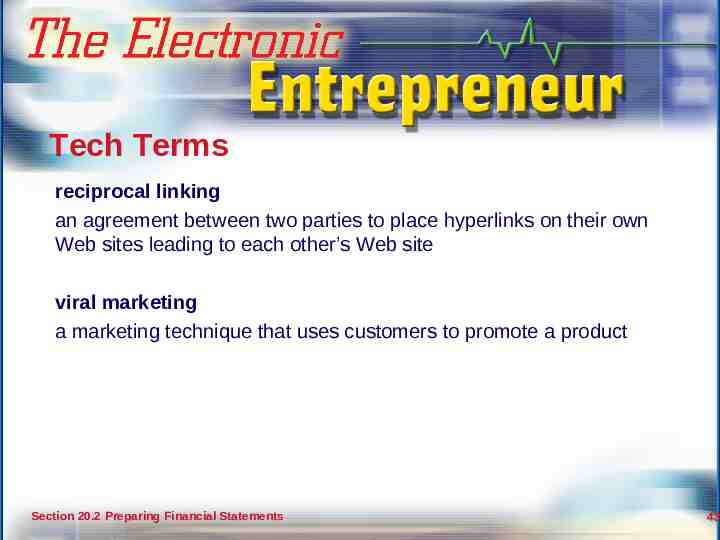
Accounting and Financial Reporting Tech Terms reciprocal linking an agreement between two parties to place hyperlinks on their own Web sites leading to each other’s Web site viral marketing a marketing technique that uses customers to promote a product Section 20.2 Preparing Financial Statements 43
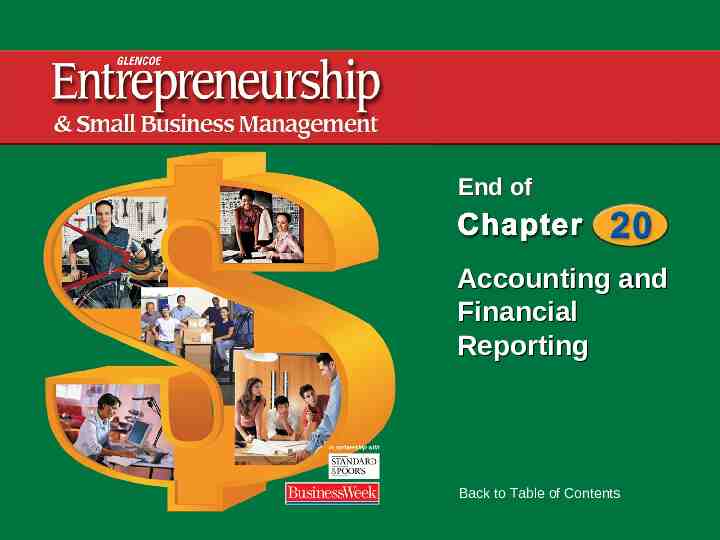
End of Accounting and Financial Reporting Back to Table of Contents



